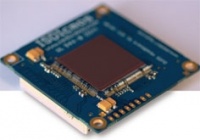UK sensors enhance electron microscopes
Advanced sensor technology could improve the quality of images from transmission electron microscopes.

One problem with such devices, however, is that because each pixel on the imager has its own set of logic associated with it, the fill factor - or the percentage area that can be used to capture electrons - can never be 100 per cent if it is illuminated from the front, unlike a CCD sensor that can achieve close to a 100 per cent fill. This problem can be overcome if the sensor is illuminated from the back
To address that particular issue, the developers have created a second class of detector that sports an entirely different architecture. In these so-called double-sided strip detectors (DSSDs), silicon strips are fabricated on both sides of a detector to provide a means of pinpointing the exact coordinates of any electrons that pass through it.
’Unlike CCDs, and APS detectors - which fall into a class of sensor called integrating detectors - the DSSDs are counting detectors that can determine the position of an incoming electron from the charge that accumulates on strips that lie orthogonally on both the front and the back of the sensor as the electron passes though them,’ said Kirkland.
Register now to continue reading
Thanks for visiting The Engineer. You’ve now reached your monthly limit of premium content. Register for free to unlock unlimited access to all of our premium content, as well as the latest technology news, industry opinion and special reports.
Benefits of registering
-
In-depth insights and coverage of key emerging trends
-
Unrestricted access to special reports throughout the year
-
Daily technology news delivered straight to your inbox










Water Sector Talent Exodus Could Cripple The Sector
Maybe if things are essential for the running of a country and we want to pay a fair price we should be running these utilities on a not for profit...